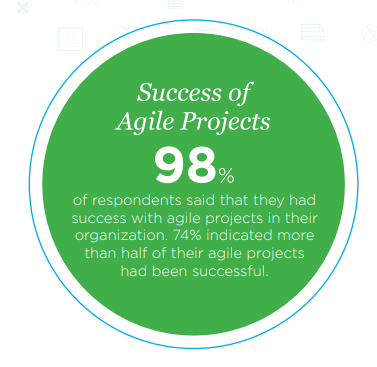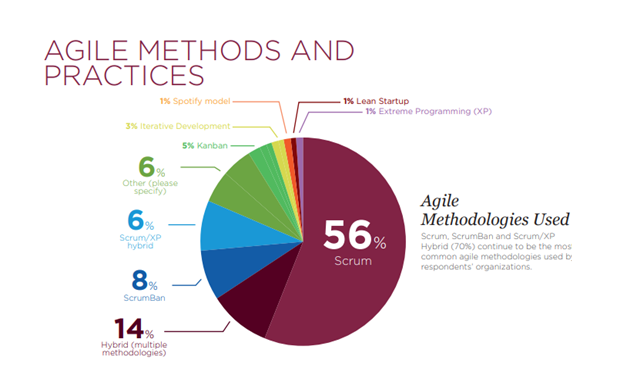What is Agile Project Management?

:
What is Agile Project Management?
Agile is an iterative and incremental method to develop software step by step taking frequent reassessment whenever required, instead of delivering the whole product after completion.
Agile Methodology is rapidly adopted by all types of organizations especially which cope with the turbulent customer-driven marketplace which resulted in rapid fame of Agile. The organization which adopted Agile Methodology observed a decrease in critical defects and an increase in productivity. It is considered highly successful and efficient.
In Agile Project Management, project activities are divided into phases termed as “Sprints”. Usually, a week span is allotted to each sprint. After completion, sprints are reviewed and evaluated by the managers. The feedbacks are taken from the stakeholders within a week. The project activities are completed within constrained time according to the feedback from the stakeholders.
Agile management relies heavily on teamwork, customer collaboration, time-boxing tasks and allows greater flexibility.
According to the 13th State of Agile Survey Report (2019),
- 71% of respondents adopted agile because it reduces project cost
- 74% of respondents adopted agile as it accelerates the software delivery
- 51% of respondents claim that adopting agile increases productivity
- 43% of respondents stated adopting agile enhances the product quality

According to the report by EY: Digital Transformation for 2020 and beyond, Global Telecommunications Study, improved organizational agility is at the heart of successful digital transformation.
The book, Agile Project Management (APM) by Jim High smith, was one of the first attempts to broaden Agile techniques into a cohesive whole.
PMI, the world’s leading project management institute for Project Management Professional (PMP), has introduced Agile in their PMBOK – 6th edition. Incidentally, PMBOK-version 6 is the reference material for their flagship Project Management Certification (PMP) course. PMP is globally acclaimed and universally recognized, and benchmark certification in project management
What are the different methodologies of Agile?
The different Agile methodologies include:
- Agile Scrum Methodology
- Lean Software Development
- Kanban
- Extreme Programming (XP)
- Crystal
- Dynamic Systems Development Method (DSDM)
- Feature Driven Development (FDD)
Agile Scrum Methodology
Scrum methodology is an implementation of agile practices based on an iterative and incremental method. According to the 12th Annual State of Agile Report, The Scrum Methodology is most widely used amongst software development teams as it divides complicated tasks to user stories.

The roles of product owner, scrum master and developer roles can be seen in this system.
Lean Methodology
Lean is an iterative methodology where the products are delivered through effective value stream mapping. The lean methodology was originally developed by Mary and Tom Poppendieck. Lean is an evolving methodology without any rigid rules and guidelines.
The main principle of Lean Methodology is to eliminate waste, fast delivery, team empowerment, continuous learning. Lean methodology eliminate waste by asking the customer to select only valuable features required. It relies on rapid and reliable feedback for faster productivity.
Kanban
Kanban is an agile methodology which relies on visual-based workflow. Kanban was developed on the production line of the Toyota factories in the 1940s. 83% of the teams using Lean methodology uses Kanban framework for continual delivery. Kanban promotes effective teamwork through continuous collaboration.
Kanban is based on 3 basic principles:
- Visualize what you’ll do today (workflow automation)
- Limit the amount of work in progress (WIP)
- Enhance flow
Extreme Programming (XP)
Extreme programming (XP) is a disciplined approach with higher customer involvement, faster feedback, work on prioritization, continuous planning, continuous testing and closer teamwork to deliver high-quality software. XP is mainly based on four simple values:
- Simplicity
- Communication
- Feedback
- Courage
The customer and development work very closely in this method to define and set the priorities. The development team works on an iteration-by-iteration to deliver a high-quality product.
Crystal
The Crystal methodology is of the most lightweight and adaptable approaches based on team size, project priority and system criticality. The crystal methodology is comprised of a set of crystal families mainly for smaller teams. Crystal promotes early and frequent delivery of working software with high user involvement and the removal of distractions. Crystal methodology doesn’t rely on fixing tools and techniques. The core elements are people and processes.
Dynamic Systems Development Method (DSDM)
Dynamic Systems Development Method (DSDM) is a common industry framework for rapid software delivery. Earlier it was called as Rapid Application Development (RAD). DSDM provides a comprehensive foundation for planning, managing, executing, and scaling Agile process and iterative software development projects. DSDM is based on eight key principles:
- Focus on the business value and need
- On-time delivery
- Collaborate
- Never compromise quality
- Build incrementally from firm foundations
- Iterative approach
- Communicate continuously and clearly
- Demonstrate control
Feature Driven Development (FDD)
Feature Driven Development (FDD) is a model-driven method with shorter iterations. It was built around software engineering best practices. The FDD is based on domain object modelling, developing by feature, and code ownership. It consists of simple activities:
- Development of an overall model
- Building a feature list
- Planning by feature
- Designing by feature
- Building by feature
Combination of Agile Methodologies
The combination of other Agile Methodologies such as ScrumBan, Scrum/XP etc. are also used in different organizations as per the requirement of the company.
The proper scaling framework is required to implement the Agile Methodology. Scalable Agile Framework (SAFe) is the most used agile scaling framework which enables to implement Agile Methodology such as SCRUM at the bigger enterprise level.
Methodologies such as SCRUM, Kanban or combination of both (Scrumban) and frameworks such as Scaled Agile Framework (SAFe), Scrum of Scrums were developed to meet the long-term planning benefits and help organizations in scaling lean and agile practice.
What are the12 principles of Agile?
The 12 principles of Agile Methodology are:
- Customer satisfaction through early and continuous quality delivery
- Welcome changes according to customer’s needs and requirement
- Business and development go hand in hand
- A collaborative approach to work
- Build projects around motivated individuals
- Promotes sustainable development
- Face to face clear conversation
- A measure of progress is working software
- Continuous attention to excellence
- Simplicity
- Self-organizing teams
- Reflect for Effectiveness
Why adopt Agile project management?
- Provides Clarity: Work is divided into phases termed as “Sprints”. Usually, a week span is allotted to each sprint. After completion, sprints are reviewed and evaluated by the managers. This way of approach provides more clarity and it also provides predictable cost and schedule.
- Enhance quality: The feedbacks are taken from the stakeholders within a week, Stakeholder engagement increases the scope of improvement and to rectify errors (if any) in the early-stages. Regular feedback from customers enhance the quality of the product.
- Encourages teamwork: It is a collaborative process which encourages constant learning and knowledge sharing. It brings out a positivity towards work culture as it encourages a team-based approach to development.
- Faster Return on Investment (ROI) as Agile Methodology focus on fast product releases which justifies the business value.
- Simple Prioritization: Setting out priorities made easier with Agile Methodology.
- Reduces risk as adopting Agile Methodology eliminates the chance of absolute project failure.
What are the benefits of doing Agile Certifications?
Any Certification plays a key role in the career path as it holds solid proof of subject matter and continuous learning. The 10 benefits of doing Agile Certification is :
1. Agile certification is globally recognized and in-demand worldwide.
2. Recognizes your expertise in using agile practices in your projects, while demonstrating their increased professional versatility through agile tools and techniques.
3. Carries a higher level of professional credibility as it requires a combination of agile training, experience working on agile projects, and an examination on agile principles, practices, tools, and techniques.
4. Supports individuals in meeting the needs of organizations that rely on agile project practitioners to apply a diversity of methods to their project management.
5. Demonstrates your level of professionalism in agile practices of project management to employers and potential employers.
6. Increases your professional versatility in both agile project management tools and techniques.
7. Accelerates the scope of your career as an Agile Certified Professional with career advancement, professional growth, and increase in salary and earning potential.
8. Enables you to stand out from the crowd as an Agile Certified Professional. Professionals with formal scrum training and an Agile certification have higher salaries than those without an agile certification, according to the Scrum Master Trends Report 2019.
9. Expands your market reach as an agile certified professional and provides you with an opportunity to network with a vibrant community of agile professionals, related organizations, and experts worldwide.
10. Invest in your future. Invest in an Agile Certification to recession-proof your career. Agile professionals would retain their value even during a recession due to their strong and highly transferable core competencies.
Adopting Agile is not about being Agile or doing Agile, It requires a change in the mindset as well to adopt change in work culture resulting in clear product vision and roadmap.
Do visit our Corporate Training to know more about core offerings for enterprises in empowering their workforce.
iCert Global offers Agile based Certification:
Download our Free PMI-ACP Brochure for more information.
For more information on how iCert Global can help you to accelerate your career with Agile certification, please e-mail info {at} icertglobal {dot} org or call now on +1-713-287-1213/ 1214 / 1053 / 1355. Visit us at https://www.icertglobal.com/










Write a Comment
Your email address will not be published. Required fields are marked (*)